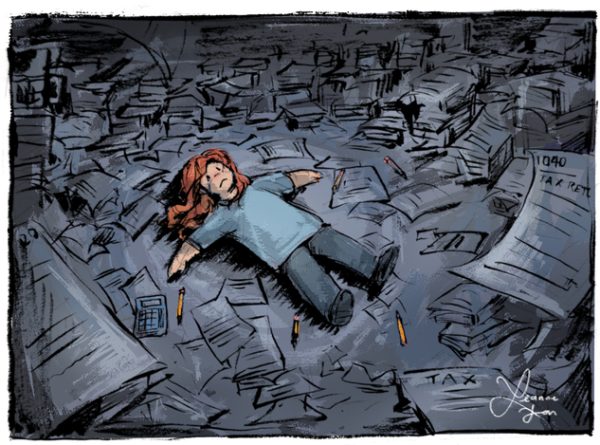
In the beginning, I felt optimistic. My taxes should be easy: I had one job over the summer and did not own any property, have any spouses, or run a business.
Taxes are a right of passage into adulthood. I’d heard adults groan about doing them before, but I thought they were like grocery shopping and vacuuming: tasks that take up a couple hours but are not truly abhorred. How wrong I was.
To begin, I typed IRS.com into my search engine. A website popped up: blue and white with a sans serif font. Looking closer, however, I saw an ad for a children’s hospital on the bottom of the page. And why is there a huge empty space on the left margin of the site? Is that type in Arial? I guess the government needs a better graphic designer.
Suspicious, I called my dad over to come look at this weird website, and he pointed out that government websites tend to end in .gov. Slapping my forehead and saying “of course,” I opened up the real IRS website.
A professional-looking site greeted me with a large photo of a man and a woman looking at a computer, grinning ear to ear, stretched across the page, no Arial in sight.
The overwhelming positivity of the scene should’ve warned me. No one looks that happy.
I asked my father where to start, and he responded with a very reassuring “Uhhhhh …”
At this moment, he chose to tell me that he uses Turbotax for our family’s taxes and hasn’t filled out the IRS forms for maybe a decade. Great.
I was under the impression that filing taxes went like this: you enter your name, address and other identifying information, and then how much money you made that year. Done.
I didn’t expect there to be math.
It wasn’t that it was hard math: simple addition, subtraction, and division made up the entirety of the form. The tricky part was figuring out what numbers to calculate.
To fill out one of the 57 boxes on the form, I had to reference a whole different document — an intimidating PDF that, if printed, would be longer than some novels.
After looking at the PDF for about five minutes, consulting its tables, and realizing that no, I don’t own a small business that has recently gotten into the market and makes over $5,000 a quarter, I put a zero in the corresponding box on my form. I would then add or subtract that number from another box.
Rinse and repeat this about 57 times, or until you decide the jail time for tax evasion looks a lot better than one more minute of this.
Sitting dejectedly at my computer, adding zero after zero to the form, I came across a box that asked for a number from something called a W-4 form. I knew what that was! One was sent to me in the mail by my employer!
Running upstairs—cause face it, I was ready to be done at this point—I opened my dad’s intimidating paperwork cabinet, and started looking at the folder labeled with my name. But, no W-4 showed up. I checked again, but nothing.
I started second-guessing myself. Did I accidentally throw it in the trash? Shred it? Is my only hope for finishing this paperwork rotting in a landfill somewhere next to a banana peel?
I got a hold of myself, and realized that it was more likely that it was just put in the wrong folder. I sighed, rifled through my sister’s adjacent manila folder, and was relieved when a small blue-gray paper filled with numbers and letters came up. I took it downstairs, and filled in the last few boxes on my tax form. Finally, I finished, signed my name, and was done.
At that moment my mom chimed in from the other room and asked how we were doing. She then casually mentioned, “You know, she might not have to do them this year. How much money did she make?”
What?!
Yeah, apparently, if you aren’t married and are under 65, you don’t have to file at all if you make less than $12,950 a year. My measly income wasn’t anywhere close to this, and so, all of it was in vain.





